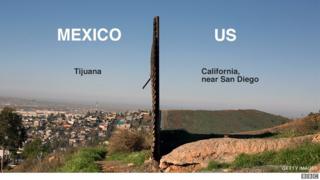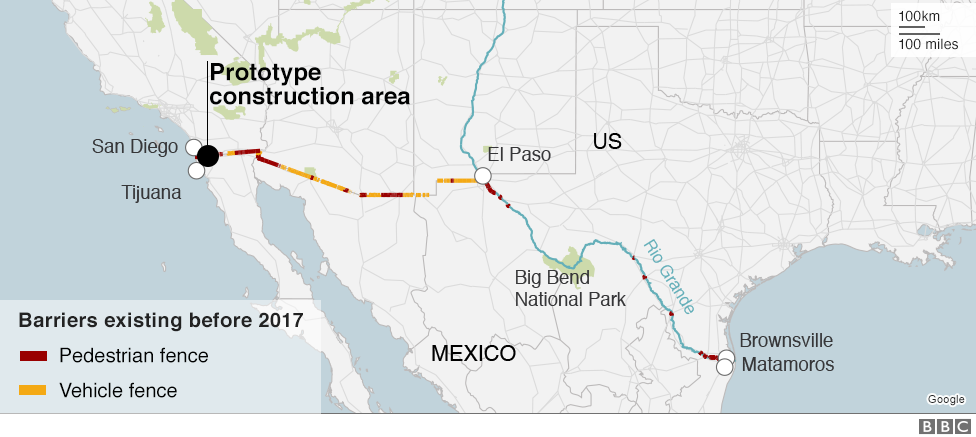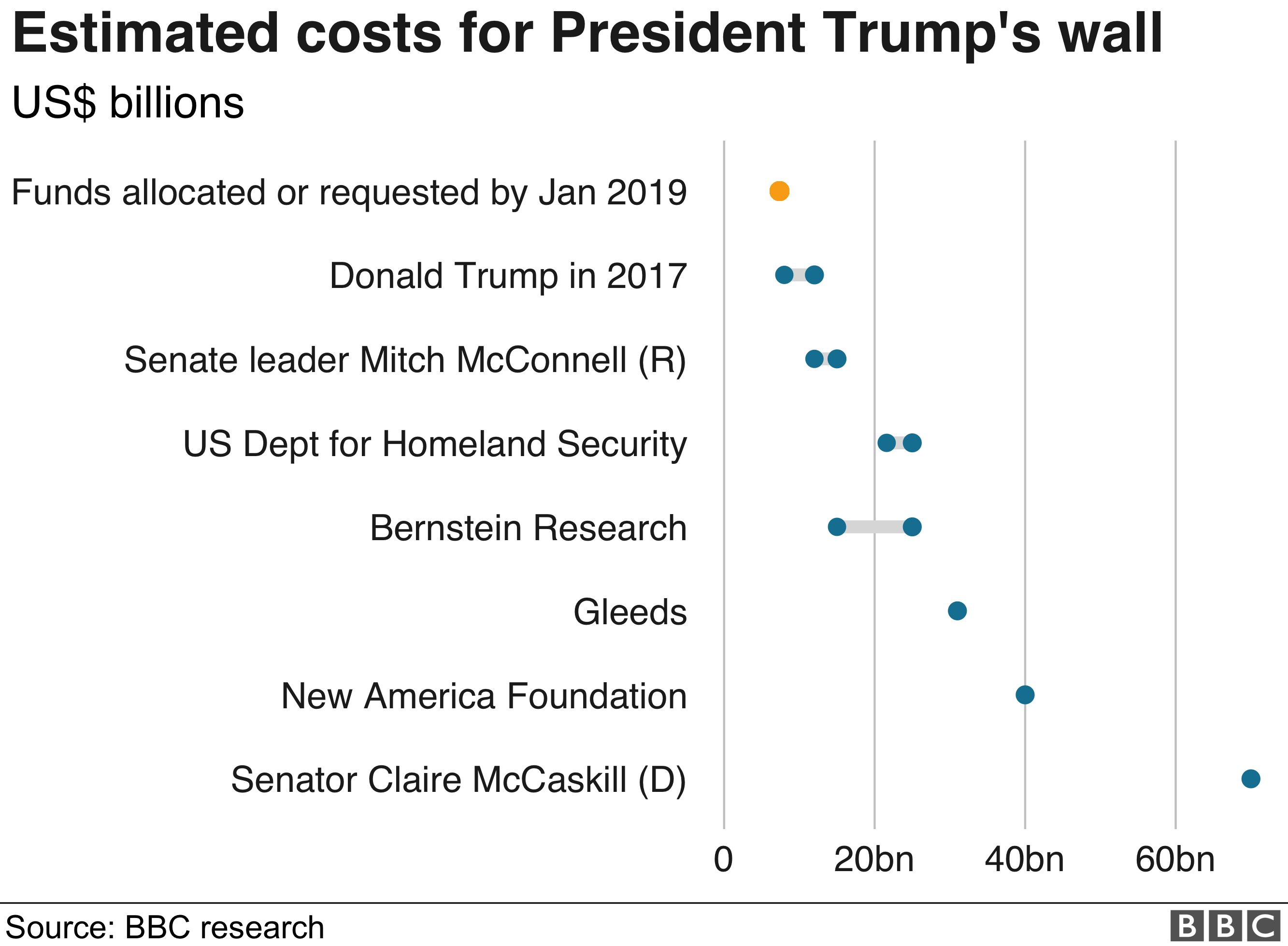Trump’s border wall – in seven charts
President Donald Trump declared a state of emergency in February over the situation at the US southern border, which has seen a rise in the number of migrants entering the country.
The emergency order has allowed Mr Trump to divert money from other projects to fund his long-promised wall after he failed to get approval for the required cash from Congress.
Lawmakers have voted twice to end the emergency, but have not yet achieved the two-thirds support needed.
Here are seven charts and maps that try to explain what the situation is like at the US-Mexico border and where we are with the wall.
1. Trump hasn’t built very much of his wall
Mr Trump has argued a wall is needed to tackle the border issue – the signature promise of his 2016 election campaign.
Before he took office, there were 654 miles (just over 1,000km) of barrier along the southern border – made up of 354 miles of barriers to stop pedestrians and 300 miles of anti-vehicle fencing.
In the run-up to his election victory, Mr Trump promised to build a wall along the border’s entire 2,000-mile length.
He later clarified that it would only cover half of that – with nature, such as mountains and rivers, helping to take care of the rest.
But, since Mr Trump entered the White House, although some of the already existing barriers have been replaced, work on extending the current barrier only began this year.
Overall, $9.8bn has been secured since January 2017 to construct approximately 509 miles of “new border wall system”, according to US Customs and Border Protection (CBP).
A total of 57 miles of replacement barrier and nine miles of new secondary barrier have been constructed – a total of 66 miles.
However, no “new wall” – any extension to existing structures – has yet been completed.
The first construction of new barrier has begun in the Rio Grande Valley, Texas, where 13 miles of “new levee wall system” is being built in Hidalgo County. The construction of an additional 11 miles is expected to start this year.
A further 15 miles of “new border wall system” is also planned in neighbouring Starr County.
The money for the barrier has come from previous funding approved by Congress as well as extra cash Mr Trump has been able to access since he declared a state of emergency
By the end of 2020, CBP says it expects to have completed 450 miles of “new border wall system” – which includes steel-bollard barriers, all-weather roads, lighting, enforcement cameras and other technology – and to have started to build an additional 59 miles.
2. No-one really knows how much it would cost
A number of widely different estimates for Mr Trump’s promised concrete wall have been put forward by official and unofficial bodies – ranging from $12bn to $70bn.
Mr Trump’s initial price tag of between $8bn and $12bn (£6.4bn and £9.7bn) for a wall covering half the length of the border was widely disputed.
The 650 miles of fencing built under President George W Bush cost an estimated $7bn, and it could not be described as fulfilling Mr Trump’s promises of a “tall, powerful, beautiful” barrier.
However, Mr Trump said earlier this year he wanted $5.7bn in addition to the $1.7bn already allocated by Congress for homeland security.
CBP says it now has $9.8bn in funding – which exceeds Mr Trump’s demands.
The agency says that, on average, it costs approximately $6.5m per mile to construct a new border wall or replace existing legacy fence.
3. Trump wanted concrete, but now champions steel
Mr Trump has changed his view of what constitutes a wall.
His promise to build a “big, beautiful wall” between the US and Mexico was a rallying cry throughout his 2016 election campaign. And early on, when he described it, he talked about concrete.
But once elected, he began talking about a barrier made of steel, so that border agents could see through it.
And in October 2017, when the Trump administration revealed eight 30ft-tall wall prototypes – they were a combination of concrete and metal.
Officials at the US Customs and Border Protection agency have said none of the Trump administration prototypes tested in 2017 met its operational requirements but did provide “valuable data”.
In September, Mr Trump visited a newly constructed section of steel barrier in San Diego, southern California.
He said the barrier was “virtually impenetrable”, “very, very hot” and had been tested by “world-class mountain climbers” – something leading US climbers have since disputed.
4. Illegal crossings at the southern border have risen dramatically after a fall
While figures show that illegal border crossings have seen an overall decline since 2000, they have been rising again since Mr Trump took office.
The current financial year has so far seen more than 800,000 people detained on the southern US border – already twice the total for 2018.
In 2000, 1.6 million people were arrested trying to cross the border illegally, while in 2017, Mr Trump’s first year in office, the number was the lowest it had been since 1971.
However, since then, large groups of Central American migrants – many of them families with young children – have begun to head towards the US.
A number of them have died trying to get into the US. They include Óscar Alberto Martínez Ramírez, 25, and his 23-month-old daughter Valeria, who drowned while trying to cross the Rio Grande river.
5. May saw the highest number of migrants for more than a decade
In May this year, almost 133,000 people were apprehended after crossing the border illegally – the highest number for 13 years.
Border Patrol Chief Carla Provost told the Senate Judiciary Committee the numbers were “off the charts” and that staff were facing an “unprecedented border security and humanitarian crisis along our southwest border”.
This rising number of families includes those fleeing violence in Central America and surrendering themselves to US authorities at the border. Many have told officials that they fear returning to their home countries.
Some have blamed the decision to slash the number of refugees allowed into the US under the Refugee Admissions Program for the rise in such claims for asylum at the border.
To apply for refugee status in the US, foreign nationals must obtain permission to enter the country before travelling, but those arriving at the US border are able to claim asylum “defensively” to prevent them from being deported back to a situation of “credible fear”.
Such claims are then referred to the Asylum Officers of the US Citizenship and Immigration Services.
And despite Mr Trump’s claims, any new border barrier is unlikely to stop these migrants legally claiming asylum at a port of entry.
6. A lot of illegal immigration is from visa ‘overstayers’
Although Mr Trump has blamed the southern border for illegal immigration, much of it also arises because people overstay their visas.
While almost 600,000 people were apprehended trying to cross the southern border illegally last year, more than 660,000 people who entered the US legally overstayed their expected departure date in 2018, according to the DHS.
Canadians were the highest group of overstayers, according to DHS figures, followed by Mexicans and Indians (it should be noted that the majority of Canadians and Mexicans enter the US by land, and the DHS Overstay Report only provides air and sea overstay rates).
7. The wall is unlikely to stop drugs coming into the US
Mr Trump has claimed 90% of heroin comes across the southern border and that a wall would help the fight against drugs.
Nationwide heroin seizures reached 7,979kg in 2017, with 39% seized at the US-Mexico border, according to the Drug Enforcement Agency (DEA).
Most of the border seizures were in the San Diego corridor – approximately 1,073kg in 2017, a 59% increase on the previous year.
While most of the heroin in the US does come from Mexico, the DEA says the majority of it is smuggled in through legal ports of entry, hidden in privately-owned vehicles or transporter lorries, mixed with other goods.
Only a small percentage of the heroin seizures were between entry points – where barriers exist or are proposed.
In fact, there are already barriers in border patrol sectors with the highest volumes of heroin seizures.
Design by Sandra Rodriguez Chillida.
Source: Read Full Article











